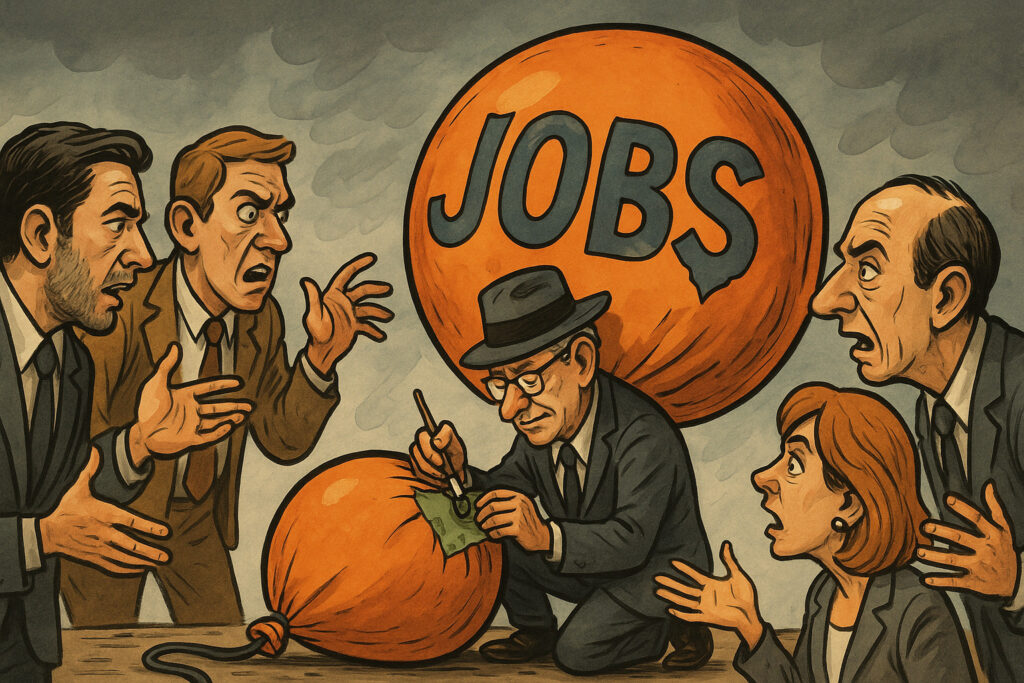Introduction
The U.S. labor market showed fresh signs of weakening in June, with the latest Nonfarm Payrolls report released on July 5, 2025, coming in below expectations for the second consecutive month. The economy added just 142,000 jobs in June, well short of the consensus forecast of 190,000 and down from May’s revised 178,000. The unemployment rate edged up to 4.2% from 4.0%, marking the highest level since November 2022.
Wage growth also moderated, with average hourly earnings rising 0.2% month-over-month and 3.8% year-over-year—both below estimates. The participation rate held steady at 62.6%, suggesting that labor supply is no longer expanding significantly. Combined, the data point to a labor market that is losing momentum amid tighter credit conditions, slower corporate hiring, and heightened economic uncertainty.
This article examines the key details of the June jobs report, assesses the market and policy reactions, and explores the implications for the Federal Reserve’s interest rate trajectory and the broader economic outlook.
Headline Numbers: Below the Mark
- Nonfarm Payrolls: +142,000 (consensus: +190,000)
- Previous month (May) revised: +178,000 (from +192,000)
- Unemployment rate: 4.2% (up from 4.0%)
- Participation rate: 62.6% (unchanged)
- Average hourly earnings (MoM): +0.2% (est. +0.3%)
- Average hourly earnings (YoY): +3.8% (est. +4.1%)
The report marks the third straight month of slowing job growth and the second month in which the unemployment rate has risen. Revisions to prior months also shaved 38,000 jobs from previous estimates, reinforcing the perception of a cooling trend.
Job gains were concentrated in healthcare (+43,000), government (+32,000), and leisure and hospitality (+26,000). However, losses in manufacturing (-11,000), transportation and warehousing (-7,000), and retail trade (-6,000) suggest continued stress in cyclically sensitive sectors.
Fed Implications: Rate Cut Odds Rise Sharply
The disappointing jobs report reignited expectations for a Federal Reserve rate cut as soon as September. Fed funds futures now price in a 76% chance of a 25-basis-point cut at the September FOMC meeting, up from 58% prior to the report.
While the June FOMC minutes released earlier this week signaled a cautious stance, several Fed officials—including Chicago Fed President Austan Goolsbee and San Francisco Fed President Mary Daly—commented post-release that the report supports the case for a “policy recalibration.”
Inflation remains a key variable. If the upcoming CPI report (due July 11) shows continued moderation, the Fed may have enough cover to begin easing in Q3.
Equity Markets: Risk-On Rebound
Markets welcomed the soft data as a green light for eventual monetary easing. The S&P 500 rose 1.1% to 5,297.55, the Nasdaq Composite jumped 1.5% to 16,761.22, and the Dow Jones Industrial Average climbed 0.9% to 39,469.78.
Growth and rate-sensitive sectors led the way:
- Technology: +1.8%, with Nvidia up 3.2% and Apple up 2.5%
- Consumer Discretionary: +1.4%, led by Amazon and Tesla
- Real Estate: +1.3%, on lower yield expectations
Investors rotated into risk assets as bond yields fell and Fed policy shifted toward accommodation.
Treasury Yields and Dollar: Dovish Repricing
Treasury yields dropped sharply:
- 10-year yield: Down 10 basis points to 4.26%
- 2-year yield: Down 13 basis points to 4.57%
The yield curve steepened modestly as short-term rates fell faster, reflecting expectations of near-term policy easing.
The U.S. dollar weakened, with the Dollar Index (DXY) falling 0.6% to 105.01. EUR/USD rose to 1.0715, and USD/JPY dipped to 159.80. Commodity and EM currencies strengthened in tandem with broader risk appetite.
Commodities: Gold Extends Gains
Gold rose another 1.3% to $2,460 per ounce, hitting a new all-time high as investors continued to seek protection against macro uncertainty and policy volatility.
Silver surged 2.1% to $32.10, while copper climbed 1.0% to $4.39 per pound. Oil prices were steady, with Brent at $70.62 and WTI at $66.90, as weak labor data offset potential supply concerns from geopolitical hotspots.
Crypto Markets: Momentum Resumes
Cryptocurrencies gained ground as macro and liquidity conditions turned favorable. Bitcoin rose 2.4% to $75,300, while Ethereum jumped 2.0% to $4,050. The rebound reflects both speculative flows and rising institutional participation in crypto-linked ETFs.
Analysts see potential for renewed momentum if dovish policy expectations persist and regulatory overhangs continue to ease.
Labor Market Internals: Structural Shift?
The June report suggests deeper shifts in the U.S. labor market:
- Small business hiring is slowing amid tighter credit.
- Temporary help services, a bellwether of hiring momentum, declined for a fourth straight month.
- Wage growth is decelerating, particularly in lower-income sectors.
These trends raise questions about the sustainability of recent economic resilience. While the labor market remains historically strong, the trajectory now points to a more cautious hiring environment.
Conclusion
The June jobs report underscored a cooling U.S. labor market, falling short of expectations and intensifying calls for the Federal Reserve to begin easing monetary policy. With job creation slowing, unemployment rising, and wage growth moderating, the path toward a September rate cut now appears more likely—pending confirmation from upcoming inflation data.
Financial markets interpreted the report as dovish, with equities rallying, bond yields dropping, and gold and crypto assets pushing higher. The shift in tone reflects a growing belief that the Fed’s tightening cycle has peaked and that stimulus may return later this year.
Key themes to watch in the coming weeks include:
- July CPI data (July 11): Will inflation fall fast enough to satisfy the Fed?
- Powell’s July 10 remarks: Will the Chair lean dovish in light of labor softness?
- Q2 earnings season: Can corporate profits hold up amid slowing growth?
For investors, the evolving labor narrative suggests opportunities in duration-sensitive assets, precious metals, and high-quality growth stocks. However, caution remains warranted, as a sharper downturn could upend even the most dovish monetary response.
